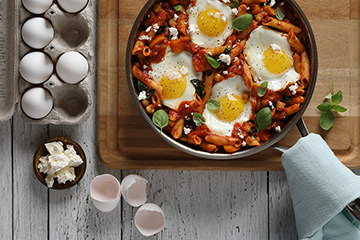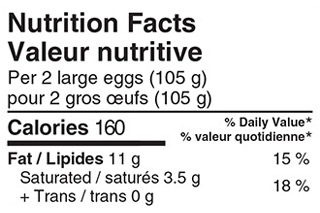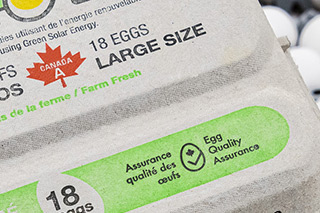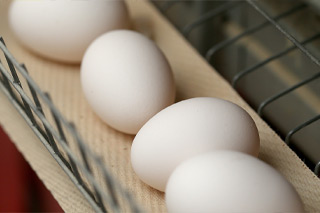Frequently Asked Questions
Buying Eggs
What causes double-yolk eggs?
A hen will sometimes produce double-yolk eggs at the very beginning or near the end of her reproductive life due to hormonal changes. When this happens, the shell forms around two yolks instead of one, creating a double-yolk egg. Double-yolk eggs are safe to eat and cook with. If substituting them for large classic eggs in a recipe, their additional volume may affect the outcome of the recipe.
Why is the yolk colour different in some eggs?
Egg yolk is determined by the diet of the hen and does not affect the nutritional value or quality of the egg. Hens fed a larger proportion of wheat in relation to other components of the diet produce eggs with pale yolks. A diet containing a high proportion of yellow corn, for example, will result in eggs with much darker yolks. The choice of grains depends primarily on the availability of these crops.
How can you tell if an egg is raw or hard-cooked without cracking it open?
Place the egg on its side and spin it around with your fingers. A hard-cooked egg will spin smoothly and rapidly. A raw egg will wobble and spin slowly because the liquid centre will prevent the egg from building up momentum to keep it turning.
How are eggs sized?
Eggs are sized by weight. Eggs in the same carton may appear to be different sizes, but their weight will be within a similar range. The following minimum weights are used to classify eggs into different sizes.
Peewee – less than 42 g
Small – at least 42 g
Medium – at least 49 g
Large – at least 56 g
Extra Large – at least 63 g
Jumbo – at least 70 g or more
How long does it take for eggs to get from the farm to the store?
In Manitoba, eggs travel from the farm, to the grading station, then to the grocery store within a week of being laid.
Are the eggs I buy from Manitoba grocery stores produced locally?
The majority of eggs sold in Manitoba grocery stores are produced right here in Manitoba by regulated egg farmers.
Why doesn't it say 'Manitoba' on my egg carton?
The locations listed on some egg cartons do not necessarily indicate where the eggs were produced. Rest assured, the majority of eggs sold in Manitoba grocery stores are produced by regulated egg farmers right here in Manitoba.
What is a Grade A egg?
There are three main things that determine Grade A quality of an egg: the condition of the shell, the position of the yolk, and the size of the air cell inside the shell. If the shell has no cracks, the yolk is centered, and the air cell is very small – it meets Canada Grade A standards. These are the eggs sold at the grocery store.
Why is there an "EQA" symbol on my egg carton?
The Egg Quality Assurance (EQA) mark is our commitment to excellence. All Egg Quality Assurance (EQA) certified eggs will come from farms that have met the highest standards of our national Animal Care and Start Clean-Stay Clean® food safety programs. For more information, click here.
What does the Best Before Date mean?
The best before date indicates the time the eggs will maintain Grade A quality, if stored properly. It is normally 28 to 35 days from the date of packing. If you use them after that date, they are better for baking, hard boiling or scrambling rather than poaching or frying.

 Affordable Meals
Affordable Meals New Recipes
New Recipes Powered by Eggs
Powered by Eggs Ho Ho Holidays!
Ho Ho Holidays! Recipe Booklets
Recipe Booklets Egg Nutrition
Egg Nutrition Care & Quality
Care & Quality Types of Eggs
Types of Eggs